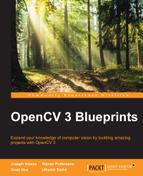Computational photography is a diverse and popular field, which combines the work of artists, technicians, and scientists. Thus, there are many types of authors, instructors, and mentors who can help you become a better "computational photographer". Here are just a few examples of helpful guides:
- Learning Image Processing with OpenCV, by Gloria Bueno García et al (Packt Publishing, 2015), covers a wide range of OpenCV 3's capabilities with respect to image capture, image editing, and computational photography. The book uses C++, and is suitable for beginners in computer vision.
- The National Geographic Masters of Photography video lectures (The Great Courses, 2015) provide great insight into the goals and techniques of master photographers. Several of the lecturers are wildlife photographers, whose use of camera traps was an inspiration for this chapter.
- OpenSource Astrophotography, by Karl Sarnow (CreateSpace Independent Publishing Platform, 2013), covers the use of gPhoto2 and other open source software, along with photographic hardware, to capture and process detailed images of the night sky.
- Science for the Curious Photographer, by Charles S. Johnson, Jr. (CRC Press, 2010), explains the scientific history and principles of light, lenses, and photography. Moreover, it provides practical solutions to common photographic problems, such as selecting and setting up good equipment for macro photography.
Whether as a hobby or a profession, computational photography is a great way to explore and chronicle the world from a particular viewpoint. It requires observation, experimentation, and patience, so slow down! Take time to learn from other people's explorations, and to share yours.
..................Content has been hidden....................
You can't read the all page of ebook, please click here login for view all page.
